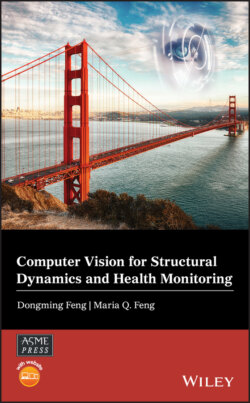Computer Vision for Structural Dynamics and Health Monitoring

Реклама. ООО «ЛитРес», ИНН: 7719571260.
Оглавление
Dongming Feng. Computer Vision for Structural Dynamics and Health Monitoring
Table of Contents
List of Tables
List of Illustrations
Guide
Pages
Wiley‐ASME Press Series
Computer Vision for Structural Dynamics and Health Monitoring
List of Figures
List of Tables
Series Preface
Preface
About the Companion Website
1 Introduction. 1.1 Structural Health Monitoring: A Quick Review
1.2 Computer Vision Sensors for Structural Health Monitoring
1.3 Organization of the Book
2 Development of a Computer Vision Sensor for Structural Displacement Measurement
2.1 Vision Sensor System Hardware
2.2 Vision Sensor System Software: Template‐Matching Techniques
2.2.1 Area‐Based Template Matching
MATLAB Code – 2D Template Matching Using NCC
Comments:
2.2.2 Feature‐Based Template Matching
MATLAB Code – Functions to Detect Interest Points and Extract Feature Descriptors
2.3 Coordinate Conversion and Scaling Factors
2.3.1 Camera Calibration Method
2.3.2 Practical Calibration Method
2.4 Representative Template Matching Algorithms
2.4.1 Intensity‐Based UCC Technique
MATLAB Code – Displacement Time History Measurement Using UCC
Comment:
2.4.2 Gradient‐Based Robust OCM Technique
MATLAB Code – Template Matching Using OCM
2.4.3 Vision Sensor Software Package and Operation
2.5 Summary
3 Performance Evaluation Through Laboratory and Field Tests
3.1 Seismic Shaking Table Test
3.2 Shaking Table Test of Frame Structure 1
3.2.1 Test Description
3.2.2 Subpixel Resolution
3.2.3 Performance When Tracking Artificial Targets
3.2.4 Performance When Tracking Natural Targets
3.2.5 Error Quantification
3.2.6 Evaluation of OCM and UCC Robustness
3.3 Seismic Shaking Table Test of Frame Structure 2
3.4 Free Vibration Test of a Beam Structure
3.4.1 Test Description
3.4.2 Evaluation of the Practical Calibration Method
3.5 Field Test of a Pedestrian Bridge
3.6 Field Test of a Highway Bridge
3.7 Field Test of Two Railway Bridges
3.7.1 Test Description
3.7.2 Daytime Measurements
3.7.3 Nighttime Measurements
3.7.4 Field Performance Evaluation
3.8 Remote Measurement of the Vincent Thomas Bridge
3.9 Remote Measurement of the Manhattan Bridge
3.10 Summary
4 Application in Modal Analysis, Model Updating, and Damage Detection
4.1 Experimental Modal Analysis
4.1.1 Modal Analysis of a Frame
MATLAB Code – Modal Analysis Using ERA
Comments:
4.1.2 Modal Analysis of a Beam
4.2 Model Updating as a Frequency‐Domain Optimization Problem
MATLAB Code – Model Updating of the Three‐Story Frame Structure
4.3 Damage Detection
4.3.1 Mode Shape Curvature‐Based Damage Index
4.3.2 Test Description
4.3.3 Damage Detection Results
MATLAB Code – MSC‐Based Damage Detection for the Beam Structure
4.4 Summary
5 Application in Model Updating of Railway Bridges under Trainloads
5.1 Field Measurement of Bridge Displacement under Trainloads
5.2 Formulation of the Finite Element Model
5.2.1 Modeling the Train‐Track‐Bridge Interaction
5.2.2 Finite Element Model of the Railway Bridge
5.3 Sensitivity Analysis and Finite Element Model Updating
5.3.1 Model Updating as a Time‐Domain Optimization Problem
5.3.2 Sensitivity Analysis of Displacement and Acceleration Responses
5.3.3 Finite Element Model Updating
5.4 Dynamic Characteristics of Short‐Span Bridges under Trainloads
5.5 Summary
6 Application in Simultaneously Identifying Structural Parameters and Excitation Forces
6.1 Simultaneous Identification Using Vision‐Based Displacement Measurements
6.1.1 Structural Parameter Identification as a Time‐Domain Optimization Problem
6.1.2 Force Identification Based on Structural Displacement Measurements
6.1.3 Simultaneous Identification Procedure
Algorithm 6.1 Iterative Procedure for the Simultaneous Identification Algorithm
6.2 Numerical Example
6.2.1 Robustness to Noise and Number of Sensors
6.2.2 Robustness to Initial Stiffness Values
6.2.3 Robustness to Damping Ratio Values
6.3 Experimental Validation
6.3.1 Test Description
6.3.2 Identification Results
6.4 Summary
MATLAB Code – Simultaneous Identification of Structural Parameters and Excitation Forces [56]
7 Application in Estimating Cable Force
7.1 Vision Sensor for Estimating Cable Force. 7.1.1 Vibration Method
7.1.2 Procedure for Vision‐Based Cable Tension Estimation
7.2 Implementation in the Hard Rock Stadium Renovation Project
7.2.1 Hard Rock Stadium
7.2.2 Test Description
7.2.3 Estimating and Validating Cable Force
MATLAB Code – Vibration Method for Estimating Cable Tension Force
7.3 Implementation in the Bronx‐Whitestone Bridge Suspender Replacement Project
7.3.1 Bronx‐Whitestone Bridge
7.3.2 Estimating Suspender Tension
7.4 Summary
8 Achievements, Challenges, and Opportunities
8.1 Capabilities of Vision‐Based Displacement Sensors: A Summary
8.1.1 Artificial vs. Natural Targets
8.1.2 Single‐Point vs. Multipoint Measurements
8.1.3 Pixel vs. Subpixel Resolution
8.1.4 2D vs. 3D Measurements
8.1.5 Real Time vs. Post Processing
8.2 Sources of Error in Vision‐Based Displacement Sensors
8.2.1 Camera Motion
8.2.2 Coordinate Conversion
8.2.3 Hardware Limitations
8.2.4 Environmental Sources
8.3 Vision‐Based Displacement Sensors for Structural Health Monitoring
8.3.1 Dynamic Displacement Measurement
8.3.2 Modal Property Identification
8.3.3 Model Updating and Damage Detection
8.3.4 Cable Force Estimation
8.4 Other Civil and Structural Engineering Applications. 8.4.1 Automated Machine Visual Inspection
8.4.2 Onsite Construction Tracking and Safety Monitoring
8.4.3 Vehicle Load Estimation
8.4.4 Other Applications
8.5 Future Research Directions
Appendix Fundamentals of Digital Image Processing Using MATLAB. A.1 Digital Image Representation
MATLAB Code – Basic Image Representation
A.2 Noise Removal
MATLAB Code – Noise Removal
A.3 Edge Detection
MATLAB Code – Edge Detection
A.4 Discrete Fourier Transform
MATLAB Code – Discrete Fourier Transform of a Grayscale Image
References
Index. a
b
c
d
e
f
g
h
i
j
l
m
n
o
p
q
r
s
t
u
v
w
z
WILEY END USER LICENSE AGREEMENT
Отрывок из книги
Computer Vision for Structural Dynamics and Health Monitoring
Dongming Feng, Maria Q Feng
.....
Maan H. Jawad and Owen R. Greulich
Engineering Optimization: Applications, Methods and Analysis
.....